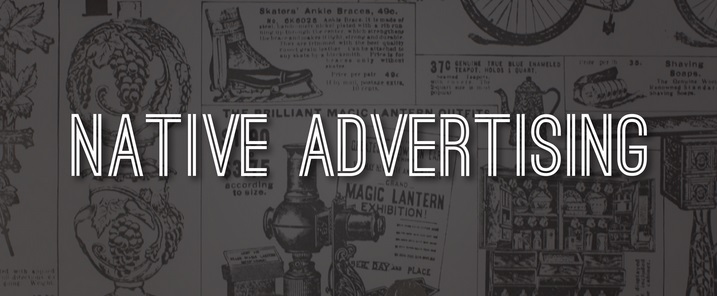Native Advertising: Three All-Too-Common Misconceptions
by Romany Reagan on 26th May 2016 in News

Native has opened an exciting new space in advertising. As the appetite for traditional advertising have been continuously decreasing for a few years, Native looks to be 'the new black' on which agencies, brands, and publishers are keen to position themselves. But, beyond the buzzword, what is Native advertising, really? ExchangeWire invites Philippe Besnard (pictured below), CEO and co-founder of Quantum Advertising, the European leader in Programmatic Native advertising, to clarify the definition of Native and explain how we have to change our approach to advertising in order to make the most of the new solutions.
ExchangeWire: What is Native advertising? Do we tend to abuse the term?
Philippe Besnard: Native has clearly become a buzzword. It is widely promoted as a win-win formula between brands and publishers, and the metrics confirm this assumption. Native helps publishers significantly increase their revenue, while preserving the quality of editorial content. As for brands, it provides fully customised advertising solutions that generate click-through rates that are 10- to 30-times higher than those of traditional display. So, it comes as no surprise that many advertising and marketing professionals are now jumping on the Native bandwagon!
The proliferation of the term has led to confusion. Every instance of in-feed placement tends to be called 'Native', but Native advertising is really much more than this. A sponsored brand message can be considered Native advertising if it is:
1. editorialised;
2. integrated to the publisher’s field of content and non-interruptive;
3. adjusted to the look and feel of each website that delivers it.
That is why content discovery and in-read (videos) have to be differentiated from Native ads, which are all about enhancing user experience. When correctly executed, Native ads create a natural path from editorial content to the advertiser’s content. The user deliberately follows this path because of the relevance of the message and the seamless integration of the ad. Here, seamless does not mean ‘intended to trick the user’, but rather non-intrusive, respectful, and well-chosen.
What can a brand expect from Native advertising, compared to traditional display ads? How should it be integrated to advertising strategy?
Native, like many new advertising solutions, takes a very different approach than traditional display. In contrast with advertising banners, Native ads are not an endpoint. Better put, they are not a destination, but rather a gateway that has to drive the target audience from the publisher’s website to the brand’s own website and universe. The logic behind Native is this: beyond just directly targeting the customer’s habits and needs, it aims to deliver value and make it appealing to continue the journey, further discovering the brand’s offering.
However, Native advertising should not be restricted to complex advertorials and deep brand content that requires heavy-duty copywriting from those involved. Value can also be created by linking advertised content with content that is already displayed on the brand’s website, social media, or other platforms. In other words: Native ads are high-quality windows to the brand’s content, and are not necessarily a reinvention of this content.
Advertisers (and publishers who provide website space to them) who want to get the most from Native ads should view them as a way to highlight the attributes of a brand or a service in an editorialised, non-intrusive manner. These selected attributes have to be sufficiently strong and relevant to engage audiences at a given moment. Carefully selected pictures, video, titles, and descriptions are a great way to editorialise and create contextual relevancy for the each content element that the advertisers want their target audience to ‘consume’.
Quantum Advertising has specialised in Programmatic Native advertising. Regarding what you’ve just said about native, can programmatic and native really be reconciled?
Programmatic advertising has opened a new era for digital. By combining dematerialised transactions, auction capabilities and data-driven targeting, it has radically transformed the economics of the digital ecosystem. But, given the massive excess of supply over demand in traditional display inventory, it has gotten a reputation for mainly facilitating the sale of distressed, unsold inventory.
However, programmatic has huge potential for Native advertising. Native provides integrated, customised pieces of content (also called 'anchors', 'teasers', etc), while programmatic provides the scale and operational effectiveness that Native has been lacking until now. Contrary to what is sometimes said, ‘Programmatic Native’ is not an oxymoron, but rather a powerful combination of complementary features.
The difficulty lies in the execution. As Native placements are, by their very nature, custom to each website and non-standard, seamless integration with programmatic technology is far from simple. That is why only a handful of companies are 100% live with Programmatic Native. Sharethrough and Triplelift have positioned themselves on this kind of technology on the UK and US markets. On the Continent, Quantum Advertising has been the first – and, to date, the only – to bet on the alliance between Programmatic and Native.
I like to think that our growth rate proves that we were right! More and more advertisers and marketers are choosing Programmatic Native in order to make the most of the two worlds. The way I see it, Programmatic Native really embodies the next generation of digital advertising: customised, integrated, content-friendly, and data-driven. With Programmatic Native, when used correctly, brands position themselves to deliver data-driven brand content throughout the customer journey, on any device, and on as many websites as needed. It is a paradigm shift for advertisers and agencies, as well as for publishers, who are in a position to sell fewer, more valuable ads.
Native Programmatic will soon represent 40-50% of display advertising. Needless to say, it will have a profound impact on advertisers’ strategies and processes. In addition to needing a clear definition – required to maintain a quality standard – we also have to change our copywriting approach and adapt to a new customer journey. In particular, oneiric visuals should be replaced by direct titles, descriptions, and a careful selection of engaging photos and videos. Ultimately, a thorough curation of the advertiser’s existing website and assets will make the difference, as Native advertising will be used to direct audiences towards the brand’s most relevant content. To that regard, we always advise our partners to think in terms of KBAs before KPIs. KBAs, or Key Brand Attributes, are to be leveraged in the native ads as a precursor to Key Performance Indicators. ‘From KBAs to KPIs’: we like to think of this as the success formula for Native Programmatic.
AdvertiserDisplayNativeProgrammaticPublisherTargeting









Follow ExchangeWire